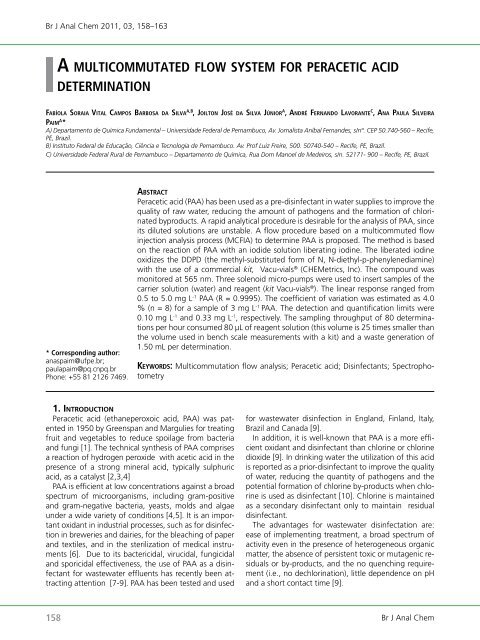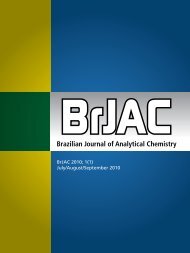Brazilian Journal of Analytical Chemistry - BRJAC - Brazilian Journal ...
Brazilian Journal of Analytical Chemistry - BRJAC - Brazilian Journal ...
Brazilian Journal of Analytical Chemistry - BRJAC - Brazilian Journal ...
You also want an ePaper? Increase the reach of your titles
YUMPU automatically turns print PDFs into web optimized ePapers that Google loves.
Br J Anal Chem 2011, 03, 158–163<br />
a m u l t iC o m m u t a t E d f l o w systEm f o r PEraCEtiC aCid<br />
d E t E r m i n a t i o n<br />
fa B í o l a so ra i a vi t a l Ca m P o s BarBosa d a silva a,B , Jo i l t o n Jo s é d a silva Jú n i o r a , an d ré fE r n a n d o la v o ra n t E C , an a Pa u l a silvEira<br />
Pa i m a *<br />
A) Departamento de Química Fundamental – Universidade Federal de Pernambuco, Av. Jornalista Aníbal Fernandes, s/nº. CEP 50.740-560 – Recife,<br />
PE, Brazil.<br />
B) Instituto Federal de Educação, Ciência e Tecnologia de Pernambuco. Av. Pr<strong>of</strong> Luiz Freire, 500. 50740-540 – Recife, PE, Brazil.<br />
C) Universidade Federal Rural de Pernambuco – Departamento de Química, Rua Dom Manoel de Medeiros, s/n. 52171- 900 – Recife, PE, Brazil.<br />
* Corresponding author:<br />
anaspaim@ufpe.br;<br />
paulapaim@pq.cnpq.br<br />
Phone: +55 81 2126 7469.<br />
aBstraCt<br />
Peracetic acid (PAA) has been used as a pre-disinfectant in water supplies to improve the<br />
quality <strong>of</strong> raw water, reducing the amount <strong>of</strong> pathogens and the formation <strong>of</strong> chlorinated<br />
byproducts. A rapid analytical procedure is desirable for the analysis <strong>of</strong> PAA, since<br />
its diluted solutions are unstable. A flow procedure based on a multicommuted flow<br />
injection analysis process (MCFIA) to determine PAA is proposed. The method is based<br />
on the reaction <strong>of</strong> PAA with an iodide solution liberating iodine. The liberated iodine<br />
oxidizes the DDPD (the methyl-substituted form <strong>of</strong> N, N-diethyl-p-phenylenediamine)<br />
with the use <strong>of</strong> a commercial kit, Vacu-vials ® (CHEMetrics, Inc). The compound was<br />
monitored at 565 nm. Three solenoid micro-pumps were used to insert samples <strong>of</strong> the<br />
carrier solution (water) and reagent (kit Vacu-vials ® ). The linear response ranged from<br />
0.5 to 5.0 mg L -1 PAA (R = 0.9995). The coefficient <strong>of</strong> variation was estimated as 4.0<br />
% (n = 8) for a sample <strong>of</strong> 3 mg L -1 PAA. The detection and quantification limits were<br />
0.10 mg L -1 and 0.33 mg L -1 , respectively. The sampling throughput <strong>of</strong> 80 determinations<br />
per hour consumed 80 µL <strong>of</strong> reagent solution (this volume is 25 times smaller than<br />
the volume used in bench scale measurements with a kit) and a waste generation <strong>of</strong><br />
1.50 mL per determination.<br />
kE y w o r d s: Multicommutation flow analysis; Peracetic acid; Disinfectants; Spectrophotometry<br />
1. In t r o d u c t Io n<br />
Peracetic acid (ethaneperoxoic acid, PAA) was patented<br />
in 1950 by Greenspan and Margulies for treating<br />
fruit and vegetables to reduce spoilage from bacteria<br />
and fungi [1]. The technical synthesis <strong>of</strong> PAA comprises<br />
a reaction <strong>of</strong> hydrogen peroxide with acetic acid in the<br />
presence <strong>of</strong> a strong mineral acid, typically sulphuric<br />
acid, as a catalyst [2,3,4]<br />
PAA is efficient at low concentrations against a broad<br />
spectrum <strong>of</strong> microorganisms, including gram-positive<br />
and gram-negative bacteria, yeasts, molds and algae<br />
under a wide variety <strong>of</strong> conditions [4,5]. It is an important<br />
oxidant in industrial processes, such as for disinfection<br />
in breweries and dairies, for the bleaching <strong>of</strong> paper<br />
and textiles, and in the sterilization <strong>of</strong> medical instruments<br />
[6]. Due to its bactericidal, virucidal, fungicidal<br />
and sporicidal effectiveness, the use <strong>of</strong> PAA as a disinfectant<br />
for wastewater effluents has recently been attracting<br />
attention [7-9]. PAA has been tested and used<br />
for wastewater disinfection in England, Finland, Italy,<br />
Brazil and Canada [9].<br />
In addition, it is well-known that PAA is a more efficient<br />
oxidant and disinfectant than chlorine or chlorine<br />
dioxide [9]. In drinking water the utilization <strong>of</strong> this acid<br />
is reported as a prior-disinfectant to improve the quality<br />
<strong>of</strong> water, reducing the quantity <strong>of</strong> pathogens and the<br />
potential formation <strong>of</strong> chlorine by-products when chlorine<br />
is used as disinfectant [10]. Chlorine is maintained<br />
as a secondary disinfectant only to maintain residual<br />
disinfectant.<br />
The advantages for wastewater disinfectation are:<br />
ease <strong>of</strong> implementing treatment, a broad spectrum <strong>of</strong><br />
activity even in the presence <strong>of</strong> heterogeneous organic<br />
matter, the absence <strong>of</strong> persistent toxic or mutagenic residuals<br />
or by-products, and the no quenching requirement<br />
(i.e., no dechlorination), little dependence on pH<br />
and a short contact time [9].<br />
158 Br J Anal Chem



